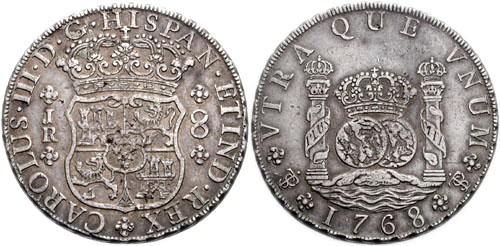The Ecosystem of Big Banks and the Mystery of the Missing Silver

18th century Spanish 8 Reales silver coin
Image credits: CNG
(Inside Science) -- A duo of recent journal papers caught my eye. They're linked by using the tools of science to address economic questions. The first examined how big banks should be regulated and the other shed light on a longstanding question, the destination of silver collected in thriving mines in 16th century South America.
Each paper details an interesting strategy for investigating problems. One thinks of banks and the economy as an ecosystem and the other uses sophisticated chemical analysis of 600-year-old coins to solve a monetary mystery.
We'll start with the banking ecosystem analysis. The research, published in October in the Proceedings of the National Academy of Sciences, was a result of the efforts of Princeton mathematical epidemiologist Nimalan Arinaminpathy, Bank of England adviser Sujit Kapadia and Oxford zoologist Robert May.
They used May's ecosystem models to simulate the banking system with a network approach. Rather than looking at the interactions between predators and prey, they looked at the interrelatedness of banks. They write that they "deliberately simplified" the models in order to explore how "contagions" and low confidence can spread and endanger the system.
The team's analysis suggests that big banks act as keystone species because should one collapse, the resulting disruption to the rest of the system grows as it ripples outward. For that reason, they say that a policy that considers larger banks more diversified and more stable, and therefore in need of proportionally less cash reserves than their smaller counterparts, is in error.
"In short, there is a tension between what might be best for each individual bank and what might be best for the system as a whole," May was quoted in a Princeton press release.
The researchers modeled multiple distributions of money amongst banks in their study. The paper highlights an interesting stat: in the first quarter of 2011, 1.4 percent of U.S. banks controlled 79 percent of the country's banking system assets.
What does it mean to have assets concentrated in that way? The researchers, drawing examples from the 2008 bankruptcy of Lehman Brothers, write that big banks are important to system stability and that "the impact of their collapse arises not only from their connectivity, but also from their effect on confidence in the system."
One of the biggest challenges for further development of this line of research, the researchers wrote, was to develop ways to quantify the importance of confidence.
The authors wrote that changing regulations to scale a bank's reserves to its importance to the entire financial system "may also have the beneficial side-effect of providing much-needed disincentives for financial institutions to become 'too big to fail.'"
Inflation, Silver and Geology
Almost 600 years ago, a different kind of economic collapse threatened the world economy. The price of goods such as wheat and hides soared in a period of great inflation. This coincided with a large increase in the world demand for silver, buoyed especially by increased demand in China. European countries turned to the New World, and found major sources of silver in what are now Mexico and Bolivia, but at that time controlled by the Spanish. At the same time, innovations made it easier to mine and process silver ore.
Economists historically blamed the massive amount of silver production for flooding Europe with money, which was followed by the inflation, but the modern understanding is more complicated and incorporates a more global perspective, especially the detail that silver was adopted for use in China's money in the 16th century. To help add an additional layer of confirmation to modern economic thought, researchers looked at the atoms of lead left behind in the refined silver used in coins to examine the number of neutrons they contained. This enabled them to deduce the age of the original silver deposit, in conjunction with other details of the coins' chemical makeup.
Researchers used the results to trace the origin of 16th century silver used in coins. By analyzing the composition of the different forms, or isotopes, of lead, silver, and copper in 15 coins from 14th-17th century England, as well as other coins, they showed that almost all of the silver in that era's European silver coins came from Europe and modern-day Mexico.
They found this despite Spanish colonial records showing that most of the silver mined in the colonies from 1576-1641 came from the Viceroyalty of Peru -- including modern Bolivia. So where did all that South American silver go?
The researchers suggest that great amounts of the silver from modern-day Bolivia's Potosi mine went to China and that it did not travel along with silver that went from Mexico to Europe. So does this mean that there was a sea-based silver trading route ranging from South America to China?
The researchers say yes.
If there was a 16th century westward silver trading route, keep in mind that the first circumnavigation of the world was initially led by Ferdinand Magellan before he was killed, and completed in 1522. The second circumnavigation was completed by Sir Francis Drake in 1580 -- and neither expedition reached Asia's Pacific coast, they skirted around the continent via various islands.
The researchers site the work of others who suggested that by the 1570s, the founding of Manila in the Philippines opened up a trade route that went from the Viceroyalty of Peru to the modern-day city of Acapulco (in today's Mexico), and on to Manila by galleon, then to China.
The paper detailing the findings, by Anne-Marie Desaulty from the Ecole Normale Superieure in Lyon, France and Francis Albarede, who is affiliated with the French university and also Rice University in Houston, Texas, was published online this month in Geology.

